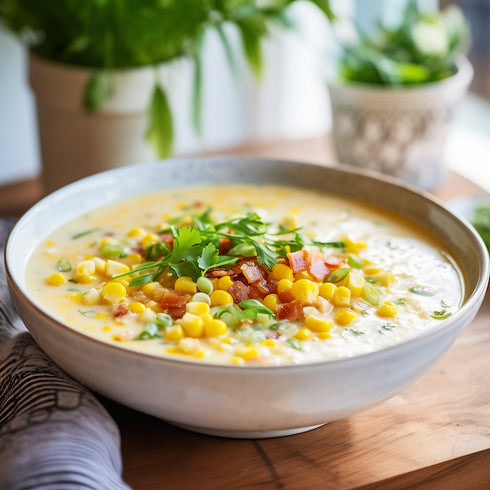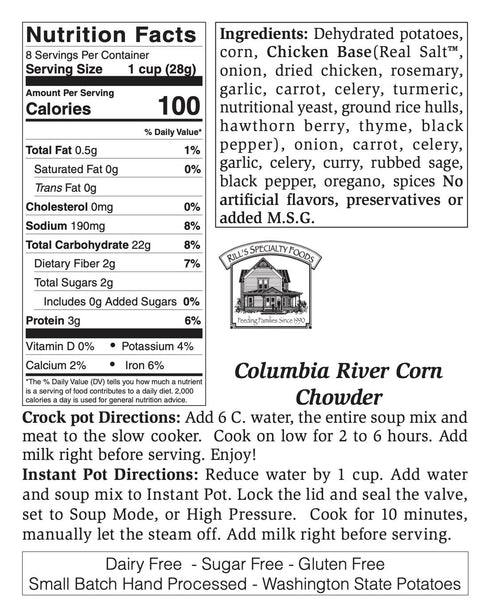Cooking Time
25 minutes
Serving Size
10 cups
Kettle Size
4 quart
Ingredients
Dehydrated potato cubes, potato flake, dehydrated corn, dehydrated celery leaf stalk, dehydrated carrot, arrowroot, herbs and spices, salt and pepper.
 Product of Washington State
Product of Washington State

Rill's Specialty Soups are a Product of Washington State.
You Will Need:
8 oz. Evaporated Milk or Milk Substitute
1/8 lb Bacon
Optional: Kielbasa or other sausage and/or grated cheese
Directions:
Chop 1/8 lb of Bacon. Cook in 3 quart sausepan until crisp; drain and discard the fat. Add 3 cups water, cover and bring to a boil. Add the contents of the soup package, stir to keep from sticking. Reduce heat to a simmer, cover and continue cooking for approximately 18 minutes, or until the potatoes are soft. Stir occasionally to avoid scorching. When the potatoes are at the desired texture add 1 cup evaporated milk or a milk substitute. Heat until warm but do not boil. Serve and Enjoy!
Great Ideas for Dressing up your Columbia Basin Corn Chowder
| Milk Substitute | Cashew milk. Using blender, add 1-1/2 cups water and 1/2 cup raw cashews. Blend until creamy. Use equal amounts as a milk substitute. |
| Add | 1/2 cup white wine or 1/2 cup sour cream. Top with grated cheddar cheese or Velveeta cheese or chives. Substitute bacon with ham or sausage or kielbasa. |
| Vegetarian | Prepare without meat, discard the yellow chicken base packet. Use 15 oz. vegetable broth and reduce water by 2 cups. If desired add meat substitute. Add any of your favorite vegetables such as carrots, summer squash, etc. |
Tidbits of History - Columbia River
The Columbia River flows for more than 1,200 miles, the origin begins at the base of the Canadian Rockies in British Columbia and runs to the Pacific Ocean at Astoria, Oregon and Washington’s Cape Disappointment. The river originates in the southeast of part of British Columbia at two lakes that lie between the Selkirk Mountains and the Continental Divide. The first 200 hundred miles of the Columbia flow north before changing course south to the international border. It continues southeast until it meets with the Snake River at which point it begins it’s southwest journey to the Pacific Ocean.
Long before the Washington territory was settled, Indians of the Moses tribe or Columbia River Indians made use of irrigation to cultivate fields of corn and potatoes at what is now known as Ephrata. They obtained the water from a creek that ran west down through a canyon.
By the 1870’s, the Columbia River’s water began to benefit Northwest agriculture and by the 1920’s major irrigation projects along the Columbia and its tributaries, of the Yakima, Wenatchee and Umatilla rivers, operated by the benefit of Federal programs. However during the 1930’s and 1940’s construction of large dams, like Grand Coulee greatly increase the irrigated land on the Columbia Plateau. In 1948, the Columbia Basin project began transporting the Columbia River waters in canals to more than 600 thousand acres of farmland in the Columbia basin. The project includes a labyrinth of canals, huge pumping stations and large center-pivot sprinkler systems. Some of the major irrigated corps includes sweet corn, beans, beets alfalfa, potatoes and orchard fruits.
The Columbia is charged by snow melt and volumes fluctuate seasonally.Its annual water flow is 160 million acre feet of water. The Columbia river flows through diverse geographical areas including, temperate rain forests with an annual precipitation of 110 inches to semi-arid plateaus with only 6 inches of precipitation. It is definitely the most significant environmental force in the Pacific Northwest. There are more than 400 dams developed on the Columbia and its tributaries.
In the Andes Mountains of South America, Pre-Columbia farmers discovered and cultivated the potato some 7000 years ago. In this harsh climate with poor soil conditions and fluctuating weather, the farmers were impressed with the plant’s hardiness, nutritional advantages and the ability to be stored. The Spanish discovered the tubular in 1537 when they marched through Peru but it was considered to be a poor mans food and was used predominately to feed hospitalized inmates.
History of Potatoes
It took three decades for the potato to gain popularity throughout the rest of Europe. In France, Antoine Augustine Parmentier, a pharmacist, chemist and employee of Louis XV realized the benefits of potatoes. He found the nutritional benefit of the potato, combined with it productive capabilities, could be a boost to the French farmer. After failing by conventional means to convince the Frenchmen of its many advantages, he decided on a surreptitious plan to make his point.
Parmentier acquired an unproductive plot of ground just on the outskirts of Paris. He planted 50 acres of potatoes and during the day hired a guard to look over it. When evening arrived, the guard was let go and the locals came to see what was of such importance. Many of the peasants believed that this plant must be very valuable and therefore took it upon themselves to “acquire” some from the plot. Soon they were growing the potato in their own gardens.
The potato gained wide acceptance across Europe and soon made its way to North America. Over time, the potato has become one of the major food stuffs of the world.








